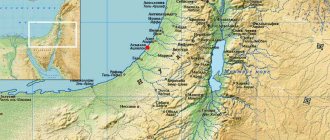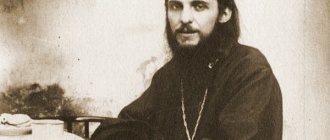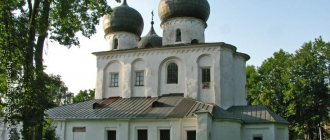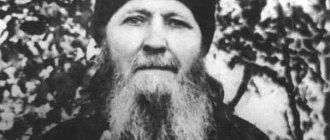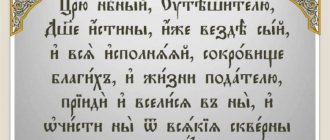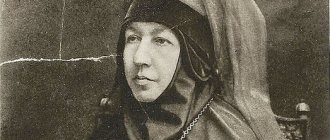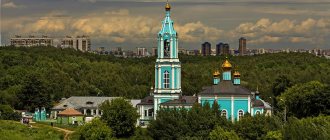| St. John Cassian the Roman |
John Cassian the Roman
(c. 350 - 435), hieromonk, venerable. Memory 29 February
Born approx. 350 in Marseilles, Gallic region - in the Western Roman Empire [1]. This is where his name “Roman” came from. By place of birth and the language in which he wrote, he belonged to the West, but the spiritual homeland of the saint has always been the Orthodox East.
In Bethlehem, in a monastery located not far from the place where the Savior was born, John became a monk. After a two-year stay in the monastery in 390, the monk and his spiritual brother Herman traveled for seven years through Thebaid, the Skete desert, Asia and Cappadocia, drawing from the spiritual experience of numerous ascetics. Having returned to Bethlehem for a short time in 397, the spiritual brothers labored in complete solitude for three years, and then went to Constantinople, where they listened to St. John Chrysostom. In Constantinople, the Monk Cassian received the rank of deacon. In 405, the clergy of Constantinople sent the monk to Rome to Pope Innocent I at the head of an embassy to seek protection for the innocently suffering saint.
The Monk Cassian was ordained to the rank of presbyter in his homeland. In Marseilles, for the first time in Gaul, he established two communal monasteries, male and female, according to the charter of eastern monasteries.
Died peacefully in 435.
By the bookshelf. Venerable John Cassian the Roman. Creations
Audio |
The great ascetic of the East and West, St. John Cassian the Roman, is widely known as an ascetic writer. Many pillars of Orthodoxy spoke with respect about his works. For example, the Monk John Climacus said that the Monk Cassian was “wonderfully and very highly wise,” and Patriarch Photius considered his writings “edifying, very useful for a pious life.” In Russia, the works of the holy ascetic were also treated with great respect. Interest in his works especially intensified at the beginning of the twentieth century and has not subsided to this day, because these works belong to the common theological heritage of the Fathers of the one undivided Church, one of whom was St. John Cassian the Roman. We bring to your attention the creations of this saint, published by the Siberian Blagozvonnitsa publishing house.
***
The Siberian Blagozvonnitsa publishing house brings to the attention of readers the eleventh volume of the series “The Complete Collection of the Works of the Holy Fathers of the Church and Church Writers in Russian Translation.” It is dedicated to the theological and moral-ascetic heritage of St. John Cassian the Roman. The book contains a dogmatic-polemical work entitled “On the Incarnation of the Lord, against Nestorius” and ascetic works - “Establishments of cenobitic monasteries” and “Conversations”. This edition opens with a foreword by Metropolitan Vladimir of Omsk and Tauride. It is to this preface that we now turn.
“Having pre-purified yourself by fasting, you gained understanding from wisdom, and from the desert God-bearing father you learned to curb passions... having become reverend, you entrusted yourself to God, and enlightening the good views, Cassian, you shone like the sun with the radiance of your Divine teachings, always enlightening the hearts of all who honor you.” Thus, in the troparion and kontakion, St. John Cassian the Roman Orthodox Church. Through the experience of asceticism (in particular, fasting), comprehension of ascetic and theological wisdom (including from holy ascetics, having a personal interview with them), prayerful communication with God by St. Cassian achieved spiritual perfection (dispassion and holiness) and “polished” the hearts of others with his teachings.
A native of the Western Roman Empire, where Latin was spoken in those days, Rev. John Cassian spent a considerable part of his life in the Christian East - in Palestine, Egypt, Constantinople. Here he met the great ascetics of the East (primarily Egypt), and with St. John Chrysostom, at that moment the Archbishop of Constantinople. From them the monk received invaluable experience and theory of Christian ascetic life, which he then transferred to Western soil, writing a series of important works. In this way, according to Bishop Vladimir, he significantly enriched Western monasticism and spirituality, which in the first centuries of Christianity were somewhat lagging behind the East, and thereby rendered great service to Western Christianity.
But what is no less important is that in his writings he reflected in a fairly systematic form the Eastern Christian spiritual teaching that he received first-hand. Therefore, his works, as Bishop Vladimir notes, are of great value for the Eastern Christian Orthodox Tradition. And in terms of clarity and completeness, they can be placed on a par with the works of such great eastern authors of the 4th-7th centuries as St. Macarius the Great, Abba Evagrius of Pontus, Venerable. John Climacus, Rev. Maxim the Confessor, Rev. Isaac the Syrian and others. But to get an idea of the personality of the reverend. John Cassian, according to Bishop Vladimir, is quite difficult.
Unlike some other representatives of Western Christianity, for example Blzh. Augustine, who wrote a lot and openly about himself in the Confessions and other works, or Blessed. Jerome of Stridon, whose personality was clearly reflected in the extensive correspondence about St. Very little is known about Joanna Cassian. Information about the life of the saint, found in his own works and in other church authors, is scanty and fragmentary. If we talk about his works, then Rev. John Cassian wrote only three major works: two ascetic ones - “Establishments of cenobitic monasteries” (about 420-424) and “Conversations” (425-429) and one dogmatic-polemic - “On the Incarnation of the Lord, against Nestorius” (about 429 -430s).
The treatise “On the Incarnation of the Lord, against Nestorius” was written at the request of the Roman Archdeacon Leo. This work is one of the very first patristic treatises directed against the neo-Storian heresy. The work “Establishment of communal monasteries” by Rev. John Cassian dedicated Castor to the Bishop of Apata. This is an essay that explains the essence, goals and rules of monastic feat. It consists of twelve books and is divided into two parts. The first talks about the external structure of monastic life and the virtues appropriate to it. In the second, we are talking about vices and passions that a monk must fight in order to acquire perfect purity of heart. The purpose of the “Institutions” “was a guide to an active life, that is, the life of an ascetic who strives for the highest level of contemplative life.”
The work “Interviews” was conceived as an addition to the “Establishments”, their completion. The work consists of 24 books and is divided into three parts, even three works, which are both independent and interconnected. In contrast to the active-ascetic nature of the “Institutions,” the “Conversations,” “on the contrary, are devoted specifically to the contemplative life, although they also include instructions regarding the active life.” And if the “Institutions” “were written by Cassian as instructions for cenobitic monasteries, then the “Conversations” were written for hermit life.”
When publishing the works of Rev. John Cassian's publishers considered it necessary to change the chronological order of his works to a value-thematic one: in the first place they placed the doctrine of the Incarnation of the Son of God, and the ascetic and soteriological teachings in the second. In addition, the publishers were guided by the principle of novelty: the treatise “Against Nestorius” had never been translated into Russian in its entirety, while the “Institutions” and “Conversations” had already been published.
***
The publication's appendix contains the work of hieromonk (later archbishop) Theodore of Pozdeevsky, who suffered martyrdom during the time of persecution for Christ, entitled “The Ascetic Views of St. John Cassian (Presbyter of Massilia).” Texts of works by Rev. John Cassian are given in a new translation and provided with theological, church-historical and textual comments. At the end of the book there is an index of quotations from the Holy Scriptures, as well as name, subject and geographical indexes. The editors hope that this publication will attract the attention of teachers and students of religious educational institutions and simply thoughtful Orthodox readers who are not indifferent to the patristic heritage and its integral component - the works of St. John Cassian.
Preliminary information
Biographical information about the childhood and youth of St. John Cassian the Roman is extremely limited. Neither the place nor the exact date of his birth is known.
According to the most common opinion, the birthplace of John Cassian was Scythia Minor (a Roman province; now the territory of Romania). The approximate time of birth is considered to be the period from 360 to 365 years.
We do not know with certainty when and from whom he received the name John. According to one version, it was given to him at baptism, according to another, when he was tonsured a monk. But there is reason to believe that he took this name for himself, in honor of his teacher and bishop, St. John Chrysostom.
John Cassian came from a pious, fairly wealthy family. The basic rules of faith and Christian morality were instilled in him from childhood.
In due time, he received a comprehensive education of the classical type, studied philosophy, ancient poetry, astronomy, and rhetoric well. In addition to Latin, he spoke Greek.
Over time, John’s spiritual education, diligence and personal talents bore fruit: he preferred the path of humble monastic life to the career of a secular husband that opened before him.
Constantinople and Roman periods
In 399, unrest arose in Egypt due to criticism of the teachings of the anthropomorphites - heretics who argued that God has features similar to those inherent in the human body.
The critical review of the anthropomorphites, voiced by Archbishop Theophilos of Alexandria, met with approval from the brethren of the community of Abba Paphnutius and, in general, from many hermits.
The heretics, dissatisfied with this course of events, flocked to Alexandria and began to threaten Theophilus. They demanded that he renounce Origenist views, and he listened to them.
In 400, Theophilus publicly denounced the false teachings of Origen. The Councils of Alexandria and Nitria, held soon after, officially condemned Origenism.
And so, the Origenist monks were persecuted and driven out of Egypt by both the clergy and the government authorities. Many monks were forced to seek shelter, food and support in other countries.
About 50 monks found sympathy in the person of the head of the Church of Constantinople, St. John Chrysostom. It is believed that among these fifty arrivals were John Cassian the Roman and Germanus.
In Constantinople, the virtues of their friends were noticed. John was elevated to the rank of deacon. In addition, he was entrusted with the position of committee of the treasury at the cathedral. In turn, Herman was ordained a priest.
When Saint John Chrysostom was unjustly accused of abuses and then expelled from Constantinople, Fathers John Cassian the Roman and Herman went to the West to seek support from the Roman Bishop Innocent I. The clergy of Constantinople provided them with a special message, which they conveyed to their destination.
After this, John Cassian remained to serve in Rome, as did his friend, Father Herman.
Father John stayed in Rome for about 12 years. There is reason to believe that it was here that he was ordained a priest, after which he received the position of adviser to the Bishop of Rome.
During his stay in Rome, John Cassian met the future Pope Leo the Great.
Monasticism
Around 380, John Cassian the Roman undertook a pilgrimage to Palestine. During the pilgrimage, he was accompanied by his longtime friend, Herman.
Here, on sacred land, the friends decided to renounce the temptations of a vain life in the world and, having received the necessary blessing, entered the Bethlehem monastery. There is an opinion that this monastery was located on the Field of the Shepherds.
While in the monastery, the friends indulged in prayer, listened to sermons, performed obedience, and observed fasts. The time came and they, having made the proper vows, took on monastic robes.
Having mastered the rudiments of ascetic experience over the years of hard work, they wanted to learn more about asceticism, strengthen their feats, and they thought of going to the homeland of monasticism, Egypt.
Egyptian period
Having prayed properly before the road, asking for blessings and promising the abbot to return to the monastery, the friends set off on the road. The path was not easy, but God was there to help them.
By sea they traveled by ship to the port of Tanis, and from there, accompanied by Bishop Archebius, they reached Panefis. There was the monastery of the famous Abba Pinufius. The Lord brought them together with the monks who lived and worked among the salt lakes, on the local hills, with Abba Nestor, Heremon, as well as with Abba Pinuphius, who lived near the monastery in a cell.
Having stayed in Panefis for some time, John and Herman, having given thanks to God, moved on and arrived in the city of Diolkos. Here they drew wisdom by communicating with the fathers: Archebius, John, Piammon and others.
The Skete desert was chosen as the next pilgrimage point. In the 4th century it was inhabited by many pious hermits.
Visiting the ascetics there, friends participated in joint prayers, were interested in various ascetic exercises, asked questions, sought advice, and listened to soul-helping exhortations.
They were lucky enough to communicate with spiritually mature fathers: Paphnutius, Moses, Isaac, Serapion, Theona, Daniel.
Soon John and Herman joined the community, which was under the leadership of Abba Paphnutius. This Abba was an Origenist monk who served as a presbyter in one of the churches of the Skete. On Saturdays and Sundays the temple was filled with hermits gathering for worship. While staying in the Skete, John Cassian the Roman exhausted his body with fasting and physical labor, and prayed a lot and sincerely.
It is stated that during this period he and Herman visited the desert of Kellia, located approximately 80 miles from Scete. There friends saw Abba Theodore.
After seven years of incessant ascetic work in Egypt, John went to Palestine, and again together with Herman. The friends wanted to fulfill the promise made to the abbot of the Bethlehem monastery, who blessed them for the pilgrimage when they were still preparing to travel through Egypt.
Meanwhile, they did not remain in Bethlehem for long and, by the Providence of God, soon returned to Egypt again.
Researchers estimate the total time of John Cassian's stay in Egypt to be ten years. During this time, he grew in spiritual age, acquired invaluable ascetic experience, acquired wisdom, and collected material for future writings.
Prayer
It is customary to turn to the icon of the saint in prayer to strengthen faith in the Lord, deliverance from sinful passions, and for help in teaching about spiritual life.
Oh, blessed and ever-memorable Our Father Cassian, cohabitant of the divine Angels, bearing the burden of the day, living in poverty, enriched with divine gifts! Now you are setting up the cathedrals of the venerables, rejoicing from the faces of the righteous, remember us who praise your virtuous life, and do not leave us helpless. Look at our life, agitated by the storms of life, so that the sinful storm does not drown us, and let the depths of destructive despair devour us. Hear the prayer of us sinners who pray, and do not despise the prayers of us weak, caught in the devil’s snares, oppressed everywhere by the evil, deprived of every good, darkened by despondency and possessed by cowardice. See, O holy one, how our soul has been humbled into the dust, and the enemy who hates us has become a joy, killing us with evil deeds all day long, for truly we have gone astray, like sheep that have no shepherd. With your God-pleasing prayers, mercifully create for us one God who loves mankind, may He not reward us for our evil deeds and the impurity of our hearts, but may His goodness precede us, strengthening our lives in peace, unanimity and piety. O blessed one, we trust in you according to God, we boast in you, we call on your holy name for help and, falling down to your miraculous image of unworthiness, we pray to you. Pray, our Father Cassian, to Christ God, so that, having been delivered from our evil ones, we may be worthy of eternal blessings with you, by the grace and bounty of our Lord Jesus Christ, blessed being with His Beginning Father and with the Most Holy Spirit forever and ever. Amen.
God bless you!
The best article for you, go to: Icon of the Mother of God Unfading Color, meaning and what it helps with
You will also be interested in watching a video story about St. Cassian:
